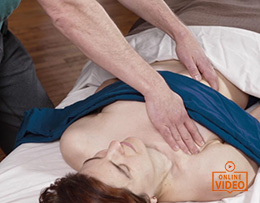

Did you know that spending just 5 minutes working the rib cage in a massage session can make it more effective?
This may seem too good to be true. It is not. To be clear: this is not a get-rich-quick scheme. This is not some kind of magic trick that sounds amazing but never quite lives up to the hype.
Creating meaningful contact with the ribs is actually hard work, requiring practice and focus and intention. It is easy to do poorly, and challenging to do right. But if you are eager for a simple, specific way to revitalize your sessions, one that will be useful for almost every client who gets on your table, read on.
For the Love of the Lateral
For the last decade or so, I have thought a lot about a part of the body that we massage therapists often don’t think very much about. The sides of the body—the lateral musculature, as opposed to the anterior or posterior musculature.
In my experience with teaching continuing education courses around the country, what I’ve noticed is that too often we massage therapists think of the body more in two dimensions than three. We get used to seeing our clients like a pancake, just a front and a back. And from there it is all too easy to get stuck in a rut. And we spend session after session pressing down, down, down, on that pancake, trying to flatten it even further.
Nobody benefits from this all too common, and all too reductive, approach to the body. The complexity of our clients’ complaints are often not addressed sufficiently, and we get bored, and burnt out, from repeating essentially the same session hour after hour, day after day.
The Solution is the Sides
But there is a solution. As I tell my students, the solution is the sides. When we see each client from all angles, rather than just as a back and a front, we increase our changes of giving a great session and getting that client back on our table again and again. And that is because we are approaching the client in the way that they want to feel: as a dynamic, three-dimensional being, capable of movement in any and every direction, rather than just a two-dimensional pancake.
I believe there is great value in focusing on the lateral musculature all the way from head to heel—from the peroneals in the lower leg, to gluteus medius and minimus, to the scalenes and masseter and temporalis.
The Rib Cage
But here I want to focus on one part of the lateral aspect of the body: the rib cage. And specifically, on the external and internal intercostals, those tiny slivers of muscle that run between each rib and the next. These muscles are a gold mine. No client will ever ask you to work on these muscles.
However, in my experience, nearly every client will benefit from this work. As I teach in my courses, this area is vulnerable, and needs to be contacted both carefully and confidently.
Find a client or a friend who trusts you and can give you honest feedback.
Start with just these two techniques.
Technique #1: Opposite-Side Lean
- Stand on the opposite side of the table from the side you want to contact (in this example, stand on the right side of the table, to work on the client’s left-side ribs). Your body should be level with the client’s shoulders but facing the client’s left hip.
- Reach across the client’s body and wrap the fingers of your left hand around the lateral aspect of the lower left ribs. Wrap far enough that your fingertips touch the table. Then think of your fingers lying in the intercostal space between each rib and the next.
- Keep your back long and straight. Now, bend your knees slightly and lean back slowly, as if you are starting to sit down in an imaginary chair. The shift of your body weight backward should lift the client’s trunk ever so slightly off the table.
- Crucial here is that you are just holding the client; your fingertips are not digging into the rib cage, and your biceps are not flexing to try and yank them higher off the table. You are just leaning back slightly, effortlessly, and allowing the intercostals to melt through your fingers.
- Once their ribs begin to slide out from your grasp, resist the impulse to grab them more tightly (they won’t like that); instead, allow the tissue to melt and wrap the fingers of your other (right) hand around the next segment of their ribs, slightly superior to where your first hand was, and lean back once again, lifting—and thus mobilizing—this next segment of tissue, again, allowing it to slowly slip through your fingers.
Technique #2: Same-Side Sink
- This time you are going to come to the same side of the table (here, you will continue to work the client’s left-side ribs, but now you’ll come to the left side of the table). Position yourself so you are level with the client’s middle ribs, but keep your body turned slightly so you are facing their occiput. Kneel on your knees, or sit on a stool or a yoga ball—whatever’s most comfortable. You should be far enough from their body so that, with your arms straight, your hands just touch their lateral ribs.
- From this position, you can reach all of those same lateral muscles from the first sequence, but with greater depth and specificity. In the first position, you were standing on the opposite (right) side of the client’s body, leaning away from their body in order to mobilize the muscles. Here, from the same (left) side of the body, you are leaning into their lateral musculature. And yet, the general angle, or direction, of your work is the same.
- Start by sinking into the intercostal muscles between the lower ribs. Rest the base of your right-hand palm on the table. Your fingertips should be pointing roughly toward the opposite-side shoulder and contacting the intercostal spaces at the lateral-most curve of the ribs. If you are in the right place, your whole hand will be pointing up at about a 45-degree angle relative to the table.
- Sink into the intercostals by leaning forward from your hips. Think of your fingers being in line with those intercostal spaces—not poking into the ribs, but rather suggesting greater movement along and between the ribs, encouraging the intercostals up and away from their current (likely stuck) position. Once again, you are suggesting the tissues up and off, or away, from the bone.
- As muscle fiber and fascia start to soften, you can adjust your right hand superiorly, into the upper ribs, and then eventually into the axilla (as we’ll see in a minute), sinking between the posterior ribs and the anterior surface of the shoulder blade.
- Remember, the client’s tissue will only allow you in if you are merely leaning, never pressing, and delivering the necessary pressure by tipping forward from your hips, rather than pushing with the muscles of your arms (just as how, in the first position, you were leaning away from the client with your whole body, rather than just yanking the client off the table with your arms).
Reveling in the Ribs
These two techniques are just the tip of the iceberg. Once you feel that you can do these techniques with care and sensitivity, start to integrate one or both into your typical massage session. Pay attention to the client’s reaction and be sure to adjust the pace and pressure as the client needs. This work should never be rushed, and should never be forced.
In my experience, these kinds of techniques nearly always make clients happy and more content.
The reasons are simple, I think. There are a number of client populations that have a specific need for work on the rib cage (for example: pregnant women; tennis players or golfers or other athletes whose sport involves a rotational movement; actors and singers and other performers who rely on their diaphragm).
Beyond those specific populations, I believe that nearly every single person who gets on your table will benefit from some attention to their rib cage.
The rationale is simple:
- A more pliable rib cage helps us to move better.
- A more pliable rib cage helps us to breathe better.
Let me explain: We get lots of complaints about specific areas in the upper body—the upper back/shoulders/neck, etc. By contrast, our clients rarely complain about pain or tension in their ribs specifically. So it is easy to ignore the rib cage and prioritize those areas where pain and tension manifest.
Work on the Rib Cage Makes Everything Else Easier
But the reality is that work on the rib cage itself makes everything else easier. We can hammer away all we want on the rhomboids and the upper traps. But until we enable the entirety of the rib cage to move more freely, we are not going to make any real and lasting progress on those chronic areas of tension—all of which lie on top of and around the rib cage.
And also: working on the rib cage helps our clients to breathe more effectively. We can remind the client of the innate pliability of the rib cage, and in turn make them feel their capacity for a slower, easier, more effortless breath. When we are able to lengthen our exhale, we encourage our parasympathetic nervous system—our ability to “rest and digest.” We are thus more calm, and more at ease.
And isn’t that what we all want from a massage?













